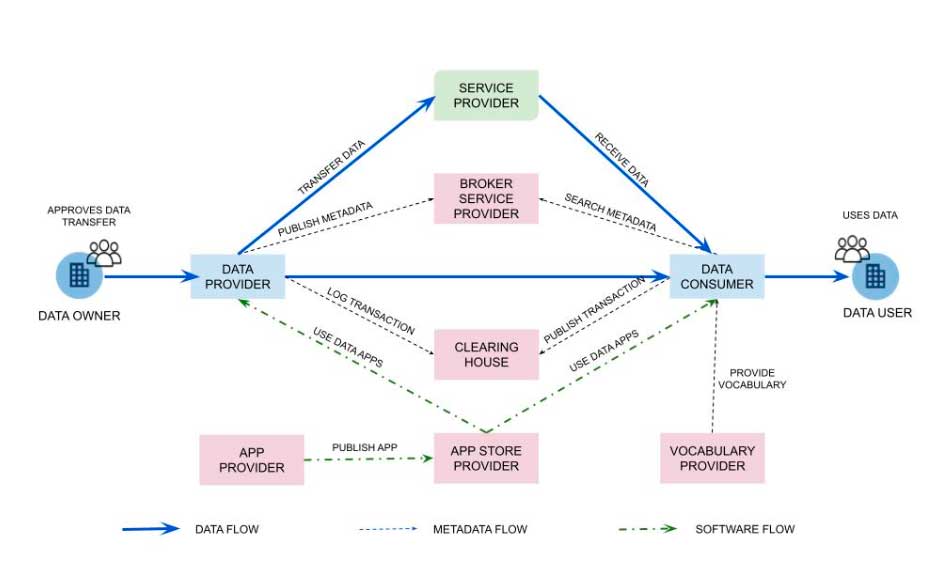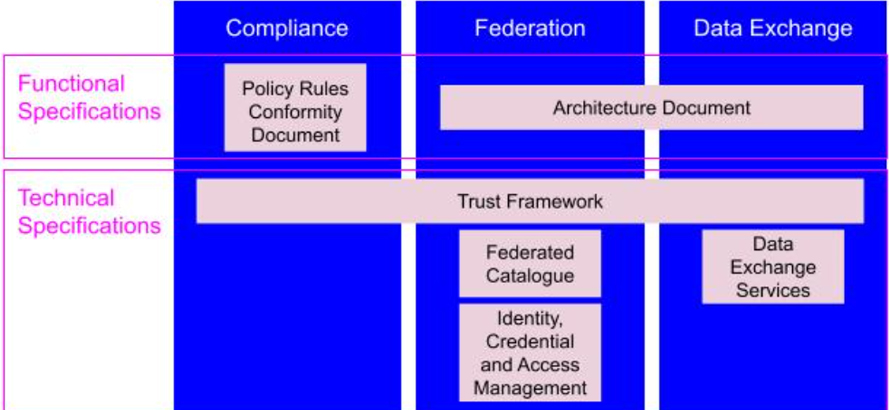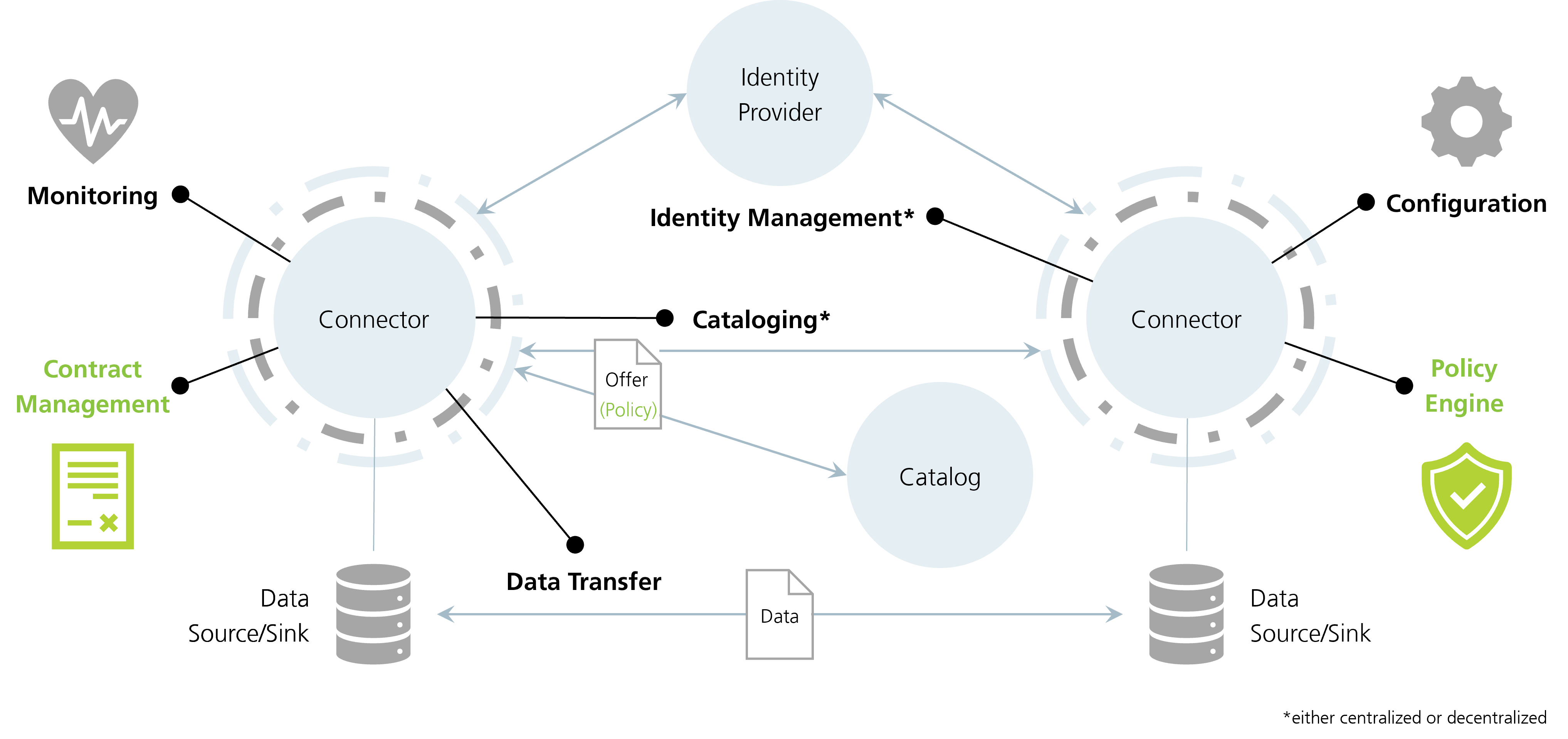We’ve explained what data spaces and organizations are before in this blog... Now, we continue the discussion on this topic to give you an overview of the technical resources available to develop a data space claim with the specifications issued by the four key organizations for the implementation of the data economy envisioned by the European Commission (EC): the Business Data Value Association (BDVA), the FIWARE Foundation, the Gaia-X European Association for Data and Cloud AISBL and the International Data Space Association (IDSA).
These data space resources provide a roadmap for engineers and engineering students who want to take the first steps in this area:
IDSA Blueprint: Specifications and Code
Let’s begin with IDSA, which has introduced a data sharing scheme called IDS. Start by exploring the IDS Knowledge-Base web page, containing references to essential content such as the IDS Reference Architecture—a blueprint for data spaces with detailed specifications, the IDSA Rulebook providing guidance on how to implement a data space based on IDSA specifications, and the Dataspace Protocol, a set of specifications designed to facilitate interoperable data sharing among data space participants. Additionally, review the Data Connector Report, a monthly report on Connectors, a core software component ensuring an isolated and secure environment for individual data services including sovereign data exchange among data space participants.
The figure below shows the roles and basic tasks within the International Data Spaces Reference Architecture. A Data Owner is a legal entity or natural person creating data and/or executing control over it. A Data Provider is an external IT service provider for data management. Frequently, a Data Owner assumes the role of Data Provider. Data flows from Providers to Consumers or directly to Data Users in case it assumes also the role of Data Consumer. App Providers create Data Apps, while those without technical infrastructure can engage Service Providers. Intermediary entities include Broker Service Providers, Clearing Houses, App Store Providers, and Vocabulary Providers. The figure does not include all roles specified by IDSA, missing Identity Provider and governance entities.
Adapted from IDSA (https://internationaldataspaces.org/publications/ids-ram/).
Ready to dive into coding? You can initiate a custom implementation using the available open-source components on IDS Github. Moreover, you can use the IDS Reference Testbed as a Minimum Viable Data Space equipped with just enough features to create a working data space with secure and sovereign data exchange. Refer to the IDS Reference Testbed for a setup featuring Open Source IDS components that allows you to verify whether a component adheres to IDS specifications for establishing connections and communication ensuring its interoperability with all other IDS components in the testbed.
Navigating the GAIA-X Specifications and Code
Now let’s jump to Gaia-X resources. The figure below illustrates the landscape of Gaia-X specifications. Begin by reading the functional specifications and then proceed to the technical specifications. The functional specification documents define how a Gaia-X compliant data space should operate, and the technical specifications elaborate on how these functional specifications should be implemented.
Adapted from Gaia-X
Then, into coding! You can access the full set of open-source projects developed by and for Gaia-X on the Gaia-X Framework page, including the Gaia-X Digital Clearing House (GXDCH) and Gaia-X Federation Services (GXFS). The GXDCH is a network of nodes dedicated to compliance components, ensuring the decentralized operation of Gaia-X compliance. It operates independently of the Association and offers an open, transparent, and secure federated digital ecosystem. The GXFS are software components necessary to set up a federated system that interconnects several participants in a data and service infrastructure with each other, aiming to develop new data-driven services and innovative products. The project has been transferred to the Eclipse Foundation and renamed as XFSC – Cross Federation Services Components.
Visit the Gaia-X Wizard, which has only recently become public. According to its documentation, Gaia-X Wizard is a web application that allows you to create and sign Verifiable Presentations as well as obtaining the Verifiable Credentials that attest Gaia-X compliance. Its purpose is to make users familiar with how VPs and VCs are used in Gaia-X, as well as provide a simple way to get Gaia-X Compliant VCs.
Already tired! Get some rest. Visit the Gaia-X Hackathons GitLab webpage and the Minimal Viable Gaia-X, from deltaDAO Team. Finally, check the Pontus-X ecosystem, a fully decentralized digital service ecosystem (a kind of marketplace) in Gaia-X, enabling technical data-sovereign data sharing and digital service monetization, while adhering to the rules of the Gaia-X Trust Framework.
The Gaia-X Spanish Hub
Make sure to visit the web page of the Spanish hub of Gaia-X. It serves as a central hub for all stakeholders in the Spanish data economy to actively engage in the initiative. Collaboration takes place through various working groups dedicated to collecting and developing sector-specific perspectives within each data space. The goal is to leverage the sector-specific knowledge of different entities, making the hub more comprehensive and fostering generous data sharing.
The Technical Convergence Document by DSBA
Are you confused with so many organizations and projects? The DSBA will come to your rescue! It has released the Technical Convergence – Discussion Document to address confusion surrounding various organizations and projects in the data space domain. The document aims to provide a cohesive view on data spaces, offering a common technical framework and aligning the technical aspects among its member organizations. Each organization brings unique capabilities to the table. BDVA contributes knowledge and a general understanding of data usage, FIWARE Foundation provides components for data exchange, decentralized Identity and Access Management (IAM) based on existing trust frameworks, and services for data publication and trading (visit the FIWARE Data Space Connector Github repository).
Gaia-X focuses on global cross-dataspace governance rooted in European values, while IDSA specializes in Data Space Connectors, Usage Contract Negotiation, and overall data space creation. The document highlights the primary objectives of Gaia-X and IDSA, which are to produce specifications, tools, and compliance testing procedures. In contrast, FIWARE works towards influencing specification development in relevant bodies and promoting rapid market adoption through an open-source implementation approach. In addition to clarifying the roles of each organization, the document includes technical content and a reference use case. It is recommended for a comprehensive understanding of the subject matter.
Cookbook for Data Spaces
The iSHARE Foundation, which emerged from the Dutch logistics sector, has published the “Cookbook for Data Spaces”. This guide aims to present the concept of data spaces in a simple way, avoiding technical language. It focuses on relevant practical applications in the current context, guiding readers through the concept, the essential components, and the process of creating functional data spaces. It is available here.
The Eclipse Dataspace Components framework
Now let’s talk about the Eclipse Dataspace Components (EDC). The EDC project, hosted by the Eclipse Foundation, provides an open source framework for sovereign, inter-organizational data sharing. It implements the IDS Dataspace Protocol (DSP) as well as relevant protocols associated with GAIA-X. The components under development are being designed in an extensible way to support alternative protocols and integrate in various ecosystems. EDC Github web page offers documentation, samples and components to implement a Minimum Viable Data Space (see figure below). The EDC community has a Discord server and periodically, they host events using its general channel. Developers are invited to get their questions answered.
Source: EDC, https://eclipse-edc.github.io/docs/#/README.
Final remarks
Data spaces can be quite intricate. Even for setting up a basic data space, you need to wade through a heap of documents and possess key skills in areas like software architectures, programming, privacy and security, and cloud technologies, not to mention knowledge representation, among others. And that’s just scratching the surface of the technical side; business and economics, organizational and governance, and legal aspects are equally crucial.
We’ve delved into most of these dimensions. We’re here to help you understand what data spaces are, the potential benefits of getting involved, and the effort versus benefits considerations. So, don’t hesitate. Reach out to us and let’s talk!
Author: Helena Fernández López, head of Data Innovation at Gradiant






